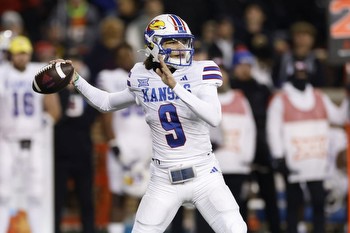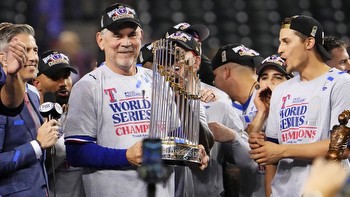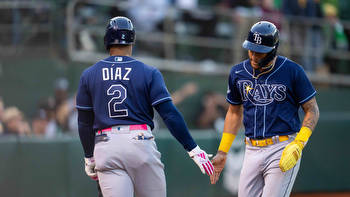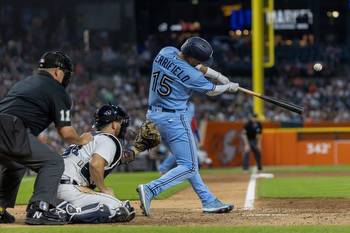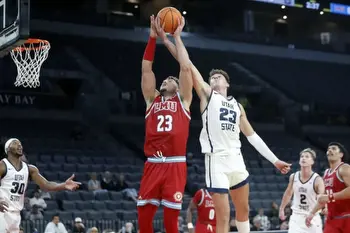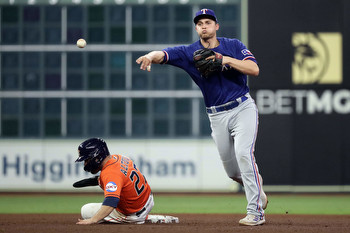Remembering the career of Blue Moon Odom
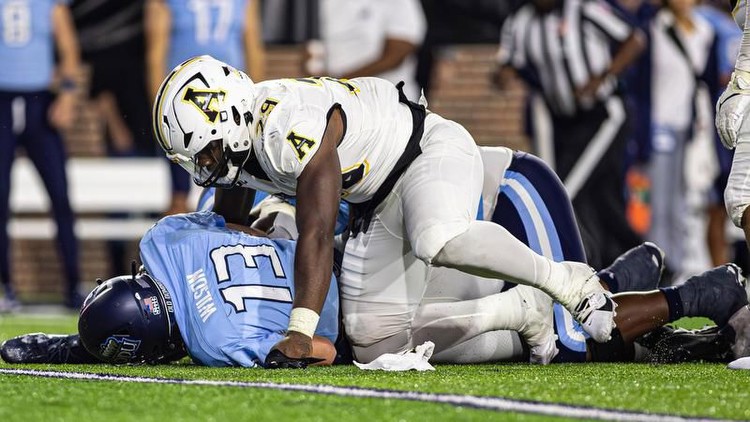
There are a few nicknames in sports that tell you exactly who the athlete is. For example, when I say “Night Train”, older fans know who I’m talking about. Same with Hammer, The Big Hurt, The Hick from French Lick or the Say Hey Kid. Blue Moon Odom was also one of those names.
Contrary to popular belief, John “Blue Moon” Odom did not get his nickname from Charlie O. Finley. Finley, always looking for a promotional idea, had a thing for nicknames. He tagged Jim Hunter with Catfish, and it stuck. He tried unsuccessfully to get Vida Blue to adopt the moniker True. Thankfully Blue declined. I mean, can you get any cooler than the name Vida Blue? No, you can’t. In fact, I’m surprised there aren’t more 45-year-old men named Vida.
Odom picked up his nickname from a junior high classmate, who thought his round face looked like a moon. So, Blue Moon it was and it was and the name became one of baseball’s classic nicknames in the 1970’s. Every time I drink a Blue Moon beer, I think of Odom.
Odom was raised in Macon, Georgia and was a multi-sport star in high school. Odom went to the same high school that produced Otis Redding and Little Richard and had early dreams of being a singer. Baseball was his best sport and the Kansas City A’s were on him early. They loved him so much that even team owner Charlie O. flew to Macon to see the young Odom pitch. Finley was so enthralled that he ordered a truckload of food to be delivered to the Odom home to entertain the extended family. Finley then went into the kitchen to help Mrs. Odom cook. That sealed the deal. The A’s signed Odom on June 1, 1964, with a $75,000 bonus, the largest ever given to a black player at that time.
Blue Moon had an electric fastball that had a late drop and a curve ball that was adequate. The A’s assigned their new prodigy to the AA Birmingham Barons, where he went 6-5 in 16 appearances. Finley was anxious to get his young charge to Kansas City, so in September the team called up Odom for a late season cup of coffee. Blue Moon made his debut on September 5, 1964, at the age of 19, in a game against the powerhouse New York Yankees. Over 18,000 fans poured into Municipal Stadium that day to see Odom. I’m sure a large swath of those fans also wanted to see the Yankees. They weren’t disappointed. Tony Kubek led off the game with a single. Bobby Richardson drew a walk. Odom got Roger Maris to ground out before giving up a long home run to Mickey Mantle. Rough start for the kid. He lasted two innings, giving up six hits and six runs.
He rebounded in his next appearance, throwing a complete game two-hitter against the Baltimore Orioles.
Blue Moon bounced between Kansas City and their various minor league affiliates for the next three seasons. He was learning how to pitch on the fly, appearing in 44 games over those three years. He threw 195 big league innings during that span, posting a respectable 3.88 ERA. Control was Odom’s biggest problem. He stuck out 114 batters but walked 123. During that time the Athletics were quietly putting together an impressive roster of young players: Sal Bando, Bert Campaneris, Dick Green, Joe Rudi, Reggie Jackson, Rollie Fingers and Catfish Hunter to name a few.
It all came together for Odom in 1968, the year the Athletics moved to Oakland. Already in his fifth big league season and still only 23, Odom appeared in 32 games, threw 231 innings, and posted an excellent 16-10 record with a 2.45 ERA. He made the first of his two All-Star appearances that summer.
Blue Moon had another solid season in 1969, going 15 and 6 with a 2.92 ERA, with an identical 231 innings of work.
The A’s meanwhile were finally putting it together, culminating in three consecutive World Series championships between 1972 and 1974. Odom played a big part in the 1972 series, making two starts and only allowing two runs in 11 innings of work. He’s best remembered for a baserunning play during Game Five of the Series. The Reds had just taken a 5-4 lead in the top of the ninth. With one out in the bottom of the inning, the A’s had Gene Tenace on third and Dave Duncan at first. Odom came in to run for Tenace. Campaneris lofted a short fly into shallow right field. Reds second baseman Joe Morgan made the catch in foul territory. Odom broke for the plate on the catch. Morgan slipped, rose and fired a strike to catcher Johnny Bench, who expertly blocked the plate and laid the tag on the sliding Odom. Home plate umpire Bob Engel made the correct call, calling Odom out to end the game. An enraged Blue Moon jumped to his feet, bumping Engel (which set him back $500) before being restrained by manager Dick Williams. I remember watching it live and it was one of the most exciting finishes to a game I’ve ever seen.
You can relive it on YouTube and the play is immortalized on a World Series card from the 1973 Topps set.
That’s a hard play to score on in any circumstance but hats off to Morgan who made an excellent throw and to Bench, who showed what a Hall of Fame catcher looks like. I remember seeing Carlos Beltran score on a similar play late in the magical 2003 Royals season.
Odom was a rarity among pitchers of his era. He was a pretty good hitter, finishing with a lifetime average of .195 while stroking 12 career home runs, five which came in 1969, a year where he hit .266. He was also used extensively as a pinch runner when not on the mound.
Things started changing for Blue Moon in 1972. In January, he was working at a liquor store in his hometown when two young men robbed a neighbor. Blue Moon ran after the perps, one who fired a few shots at him. Odom took grazing shots to the neck and side and spent a few days in the hospital recovering.
During the 1972 ALCS against the Tigers, Odom and Blue got into an altercation after Blue saved the deciding Game Five win for Odom. The A’s were a colorful bunch in those days. As a side note, the 1972 ALCS series against the Tigers and the 1972 World Series against the Reds were both classics. The ALCS went five games with three of those decided by one run. Two of those games went to extra innings. Aside from the Odom-Blue fisticuffs, you had the Bert Campaneris bat throwing incident in Game three and in Game five, A’s star Reggie Jackson tore his hamstring while stealing home (part of a double steal). Jackson missed the entire World Series, making the A’s a heavy underdog to the Big Red Machine. At the time, I thought there’s no way the A’s can win this World Series, yet they did. The series went seven games with six of them decided by just one run. The A’s won Game four with a two run, bottom of the 9 rally which was followed by the Red’s game winning double play in Game five. Baseball doesn’t get much better than that.
Prior to the 1974 World Series, Odom and Rollie Fingers had a locker room fight which resulted in Fingers getting six stitches to the back of his head. Evidently Fingers was going through a rough divorce and Odom (and a few other teammates) were making remarks about Fingers soon to be ex. If those guys weren’t fighting against Charlie O. Finley, they were fighting each other.
Odom’s production fell off in 1973 and he battled various arm injuries. Oakland traded him to Cleveland in 1975 where he appeared in three games, before being traded to Atlanta. The Braves shipped him to the White Sox in June of 1976 where he appeared in eight games. Unable to find any takers for the 1977 season, Odom went south of the border, playing parts of two seasons in Mexico, before calling it a career at the age of 33.
His last career big league win came on June 28, 1976, as a member of the White Sox and it was one for the ages. Making the start against his former teammates in Oakland, Blue Moon twirled five no-hit innings. Francisco Barrios came on in relief and threw the final four innings of no-hit ball, giving Odom a piece of his first career no-hitter. It was a strange game, with the Sox winning 2-1, as Odom and Barrios combined to walk 11 Athletics. Only 3,367 fans were in attendance that night. Seems like Oakland’s attendance problem goes way back. It was a sweet redemption for Odom, who lost a more traditional no-hitter on June 7, 1968, when the Orioles Davey Johnson hit a two-out, ninth inning single for the spoiler.
In retirement, Odom had a couple brushes with the law and spent some time in rehab before getting his life in order. Nowadays, he spends most of his time on the golf course. In 2004, Odom was inducted into the Georgia Sports Hall of Fame. If the Athletics were to move to Las Vegas, I hope that the colorful history of the A’s is somehow kept alive.
Odds and ends
Watching the playoffs this season, one of the announcers made a comment about a pitch missing, in his words, “middle-middle.” For some reason, that struck me weird. I understand the concept of middle-high or middle-low, but shouldn’t middle-middle just be middle?
Do you ever suffer from those throwback moments, when you first notice something has disappeared or changed? I had one the other night. A guy got hit by a pitch, usually a painful experience. A gaggle of trainers ran out to attend to him, mostly just talking. The batter, properly mollified, shook it off and took his base. Then it hit me, what happened to the days when a trainer would come out and spray the affected area with a cold spray? When did that change?
Turns out that magic spray is called ethyl chloride, and it’s now listed as a hazardous substance. It appears that baseball trainers are still using the stuff, just not on national TV. Evidently, it’s big with soccer players when they are faking an injury but I do miss the days when baseball trainers would use the stuff.

